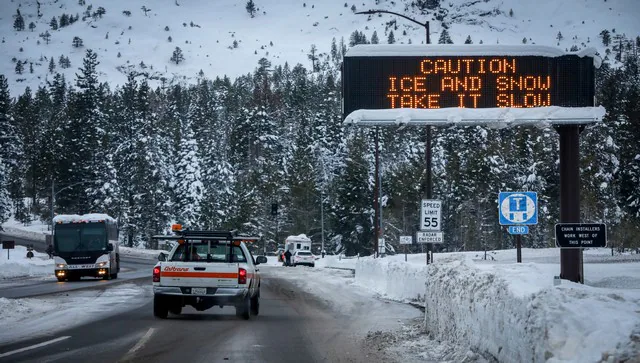

As the city of San Francisco prepared for a massive “bomb cyclone” on Wednesday, bars and restaurants were closed.
As a series of winter storms rip across the western US coast, California is expected to experience excessive rain, heavy snow, and landslides through Thursday. This has prompted the governor of the Golden State to declare a state of emergency.
The National Weather Service (NWS) is advising of coastal flash flooding and mudslides in wildfire-damaged terrain. The incoming system is expected to bring even more rain to California, which is already saturated with rain.
Atmospheric rivers, which are formed when moist air from the oceans is drawn into the most populous state in the United States, have lashed the state, bringing snow to the Sierra Nevadas, causing flooding in Sacramento County, and gusty winds to San Francisco.
According to the National Weather Service (NWS), “a significant atmospheric river event will affect California through Thursday with heavy to excessive rainfall, flooding with debris flows and landslides near recent burn scar areas, heavy mountain snow, and high winds.”
On Wednesday, Governor Gavin Newsom authorized the National Guard to assist in the disaster response and declared a state of emergency. A large portion of California, particularly San Francisco and Sacramento, has received ominous warnings about threats to life and property.
During the early hours of Thursday, the Bay Area National Weather Service advised people not to travel unless absolutely necessary, and a flood watch was in effect for more than 34 million Californians.
As San Francisco braced itself for a massive “bomb cyclone” on Wednesday, a sudden and sharp drop in air pressure, bars and restaurants were closed, and local media reported long delays on public transportation and flooded roads.
During the storm, a gas station canopy collapsed in South San Francisco.
According to the PowerOutage.us website, as of early Thursday, approximately 190,000 customers across the state were without power, dozens of flights had to be canceled, and some schools had already canceled classes.
Residents who were concerned about flooding received thousands of sandbags.
Deepak Srivastava stated to CBS in San Francisco, “We’re very worried about it.”
“We’re just crossing our fingers and hoping we won’t have more damage. (I) just spent all day putting sandbags in front of the garage at every entry point.”
City officials claimed to be working continuously.
Rachel Gordon, a member of the city’s public works department, stated, “We’ve been working very hard to source sandbags from wherever we can in northern California.”
However, she cautioned residents to take the storms seriously.
“Please don’t go out on the roads if you don’t have to be in San Francisco.”
“Several storms” The storms come after weeks of near-record rainfall.
A storm struck northern California on New Year’s Eve, breaching levees and flooding roadways as well as causing landslides and power outages.
It is known that being trapped in a submerged vehicle resulted in the death of at least one person.
On December 31, San Francisco saw almost 5.5 inches (14 centimeters) of rain, making it the second-wettest day ever recorded for the city.
According to meteorologist Matt Solum, this storm’s risk would be made worse by the waterlogging brought on by previous storms.
He stated, “This storm alone without the previous storms would cause concerns about localized flooding, rock slides, and mudslides.”
“However, due to the recent wet conditions, a lot of the precipitation that has already fallen has already saturated the ground, so any additional precipitation will run off rather than soak into the ground.”
Scientists say that a warmer planet brings more unstable weather—stronger storms and longer, hotter dry spells—despite the difficulty of drawing a straight line from human-caused climate change to this storm.
River and reservoir levels are alarmingly low as a result of decades of below-average precipitation in the western United States.
Solum stated that while any rain helped alleviate the drought, which was a long-term problem, these consecutive storms could be destructive because the water had nowhere to go.
He stated, “It’s just the compounding effect of all the storms is what will be the most impactful.”
We typically do not experience as many storm series with this much heavy rain.
And there will be more.
He stated, “It’s definitely going to continue.”
Over the weekend, we anticipate another one. And then, possibly for the following week, additional storms. and possibly even the following week.